What about something like the FaitalPro 6RS140. In my head I have a vision of a version of the solana that goes down to 200hz
For a pure top (mid/high speaker), you'd definitely want to go CB rather than BR. With that, and minimal depth to fit the drivers, the Solana can get to as close as, rough calculation, 12l rear net volume.
Simulated (in WinISD) as a 4th order bandpass, we can get to a result quite similar to the raw measurements; blue 6NDL38, green 6RS140, red the 6ND430 galucha named:
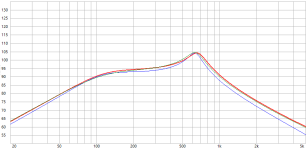
And Max. SPL (@ Xlin and AES power handling):
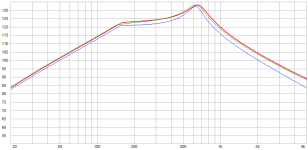
then crossed with a pair of 12in drivers flanking it similar to how JBL and Lacoustics have their line arrays setup
That would definitely lead to a very controlled horizontal off axis behavior.
the rear port tuning affects air velocity coming out of the front ports inside the waveguide by reducing cone excursion around Fb
That statement definitely hits home. Just very recently, I've printed a part, to test fit a different driver, especially clearance of the membrane to the waveguide at maximum excursion - and I can tell you, with no rear port to limit excursion, at full load at low frequencies, the front ports are basically a fan. Even in the midbass region, it still seemed like somewhat of an issue. Then again, nothing that should be unexpected, given your compression measurements showed up to 2,5 dB compression in the bass area.
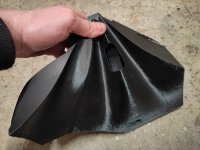
What about something like the FaitalPro 6RS140. In my head I have a vision of a version of the solana that goes down to 200hz, then crossed with a pair of 12in drivers flanking it similar to how JBL and Lacoustics have their line arrays setup.
That driver wasn't on my radar, but it should be a viable candidate as stoneeh mentioned. I'll make a note to add it to the next update to the guide.
I do think in the future I want to explore more modular, scalable approaches to point sources that can cover 200Hz-upwards. For the work I do in the soundsystems realm, there's a lot of appeal in getting a coherent, controlled directivity top that can cover precisely that range. It lends itself really nicely to crossover to a dedicated bassbin section covering 60-200Hz or somewhere around that. Maybe that will be a further iteration of the Solana that's more purpose built for high output and utilizing a 1.4" comp driver.
Presume that You heard port noise, was the port velocity over 17m/s? I believe Scott Hinson did some measurements on port noise vs velocity.I can tell you, with no rear port to limit excursion, at full load at low frequencies, the front ports are basically a fan. Even in the midbass region, it still seemed like somewhat of an issue. Then again, nothing that should be unexpected, given your compression measurements showed up to 2,5 dB compression in the bass area.
That's really not that easy of a question & answer. The amount of noise has to do with not just the air speed, but if the exit has rough edges etc which would disturb the air flow. And the issue of port noise is a completely separate one from that of port compression. As for noise, I may eventually do a video recording of the test I mentioned (driver at max. excursion, front port at full load) to just let everyone see, listen & judge for themselves.
This may be a dumb suggestion, and you may have already explored this but I had the thought of lining the front ports with a thin cotton, wool, or foam to reduce those high frequency resonances the ports have caused. I dont know how much it would affect performance in other aspects just a brainstorm idea.
I did attempt various arrangements of melamine foam inside the ports with the B prototype. Doing this did smooth out the response of the compression driver, and even increased midrange sensitivity of it. The cost however was significantly less bass output for the 6.5"s. I think that strategy may be more viable for 3-way MEHs where you aren't necessarily needing bass output from the midranges, although I may revisit the idea with different density foams/polyfil, etc.

10ms gate. Not SPL calibrated

Woofer response was taken indoors, so ignore the wiggles - more focused on the overall difference in sensitivity. 25 cycle FDW. Not SPL calibrated
10ms gate. Not SPL calibrated
Woofer response was taken indoors, so ignore the wiggles - more focused on the overall difference in sensitivity. 25 cycle FDW. Not SPL calibrated
This may be a dumb suggestion, and you may have already explored this but I had the thought of lining the front ports with a thin cotton, wool, or foam to reduce those high frequency resonances the ports have caused. I dont know how much it would affect performance in other aspects just a brainstorm idea.
I cut magic sponge discs to put in the four 3/4" mid-range ports on my syn10 , that has four 4ndf34's. Can't say it changed anything worth mentioning with the CD's response (dcx464), or the mids either really.
This may be a dumb suggestion, and you may have already explored this but I had the thought of lining the front ports with a thin cotton, wool, or foam to reduce those high frequency resonances the ports have caused. I dont know how much it would affect performance in other aspects just a brainstorm idea.
Edit: maybe you meant the influence the mid section ports have on the response of the compression driver; in this case, ignore my post. But if you meant what I initially assumed you meant, see below ⬇
Any type of resonator should only be excited at its desired (low Q) resonance (bandpass, quarter wave, Helmholtz, ...), not at its undesired (high Q) higher resonances (double wavelength modes).
For example, a bassreflex speaker with a tuning at 40 Hz and large enough port usually has the first standing wave occuring at somewhere around 200 Hz, so it needs to be crossed over significantly lower than that (recommended: an octave below or lower; in this example ~100 Hz).
Same principle here - we have the front ports of the mid section acting as a bandpass (with peak around 600 Hz), and we need to set a lowpass filter low and steep enough for any higher modes of the front ports to not get excited. This eliminates the need for any damping of the front port.
For example, a bassreflex speaker with a tuning at 40 Hz and large enough port usually has the first standing wave occuring at somewhere around 200 Hz, so it needs to be crossed over significantly lower than that (recommended: an octave below or lower; in this example ~100 Hz).
Same principle here - we have the front ports of the mid section acting as a bandpass (with peak around 600 Hz), and we need to set a lowpass filter low and steep enough for any higher modes of the front ports to not get excited. This eliminates the need for any damping of the front port.
Last edited:
Great work as usual, thank you for the Solana plans.
What is the reason you suggest using polycarbonate filament for FDM printers? I did some quick datasheet diving and see that polymaker's PC is about 2/3 as stiff as their PLA pro. I'm assuming more stiffness is better considering you recommend carbon filaments, though this may just be to provide less warping and higher dimensional accuracy. Why not use something super stiff like PPA-CF? Siraya Tech TDS says it's about 2-3 times stiffer than typical PLA.
PC and PETG bond to itself really well which would help prevent air leaks, on the other hand.
What is the reason you suggest using polycarbonate filament for FDM printers? I did some quick datasheet diving and see that polymaker's PC is about 2/3 as stiff as their PLA pro. I'm assuming more stiffness is better considering you recommend carbon filaments, though this may just be to provide less warping and higher dimensional accuracy. Why not use something super stiff like PPA-CF? Siraya Tech TDS says it's about 2-3 times stiffer than typical PLA.
PC and PETG bond to itself really well which would help prevent air leaks, on the other hand.
Regarding the question of the origin of the the difference (especially in the very high frequency (VHF) region) between turntable and Klippel NFS directivity measurement results (see page 5 of this thread); I recently built a modded Solana, and performed some diagnosis:
On turntable, 5° steps, gated (valid from about 500 Hz up), HF section only; turn axis appx. at the exit points of the front ports, 1m distance to microphone:
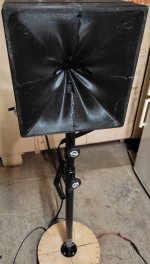
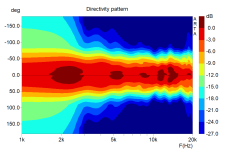
Turn axis at the very front of the speaker; 1m distance:
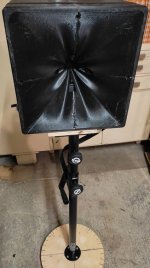
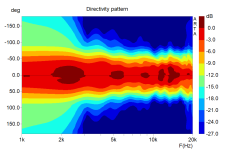
Turn axis at the very front of the speaker; 2m distance:
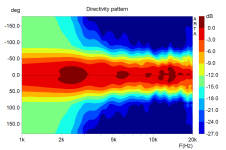
The 2m measurement is a tiny bit tighter up top, but overall the differences between the measurement setups are minute. My measurements are pretty close to JW's original ones, which would seem to confirm those, meaning nothing went wrong there; and both are pretty far from the NFS' result in the VHF region (this chart; reposted from earlier in the thread, cut to the same frequency region):
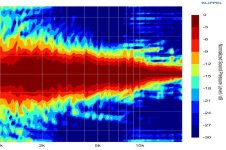
The Klippel NFS can yield results close to a turntable setup, as I myself demonstrated, and probably should do so here. As I myself remarked earlier, the differences in this case are probably just a matter of settings / setup of the NFS, not a consequence of the inherent capabilities of the machine.
On turntable, 5° steps, gated (valid from about 500 Hz up), HF section only; turn axis appx. at the exit points of the front ports, 1m distance to microphone:


Turn axis at the very front of the speaker; 1m distance:


Turn axis at the very front of the speaker; 2m distance:

The 2m measurement is a tiny bit tighter up top, but overall the differences between the measurement setups are minute. My measurements are pretty close to JW's original ones, which would seem to confirm those, meaning nothing went wrong there; and both are pretty far from the NFS' result in the VHF region (this chart; reposted from earlier in the thread, cut to the same frequency region):

The Klippel NFS can yield results close to a turntable setup, as I myself demonstrated, and probably should do so here. As I myself remarked earlier, the differences in this case are probably just a matter of settings / setup of the NFS, not a consequence of the inherent capabilities of the machine.
Great work as usual, thank you for the Solana plans.
What is the reason you suggest using polycarbonate filament for FDM printers? I did some quick datasheet diving and see that polymaker's PC is about 2/3 as stiff as their PLA pro. I'm assuming more stiffness is better considering you recommend carbon filaments, though this may just be to provide less warping and higher dimensional accuracy. Why not use something super stiff like PPA-CF? Siraya Tech TDS says it's about 2-3 times stiffer than typical PLA.
PC and PETG bond to itself really well which would help prevent air leaks, on the other hand.
Impact resistance & good layer adhesion is kind of the main reasons I put polycarbonate on the list. Although it can be challenging to use as it warps very easily during printing. Stiffness really isn't quite as important. The ABS-like resin I'm using in the ones I've built actually has a bit of give/flexibility which may actually be a good thing as it makes for a less brittle print.
PPA-CF wasn't on my radar, but with the abundance of new filaments constantly being released, it's a bit hard to test each one. Looking at the data sheet though, seems like a viable candidate.
In that case I would think carbon fiber filaments would be the worst option as they generally decrease layer adhesion and impact resistance and increase stiffness/brittleness.
Any kind of fiber additive, or matte filament, and probably white color should be avoided. Straight PETG or PC is probably the best commonly available filament with those criteria.
Thinner layer heights give better layer adhesion as well.
Any kind of fiber additive, or matte filament, and probably white color should be avoided. Straight PETG or PC is probably the best commonly available filament with those criteria.
Thinner layer heights give better layer adhesion as well.
Thanks for the input! I'll have to do some more testing on my end then. It seemed like PETG-CF printed slightly easier on my setup (less warping). But I may have to return to the PETG I'm using and play with settings some more.
Interesting that your results look even closer to the original ABEC sim than my own measurements.


Thanks for providing the extra data points! Agreed regarding your comment, and leaning towards thinking it's just a difference in setup/settings on the NFS then.
Thanks for providing the extra data points! Agreed regarding your comment, and leaning towards thinking it's just a difference in setup/settings on the NFS then.
It is yes.
Just for visual comparison's sake, I loaded the Klippel files into vituixcad to see how they look against what I measured using the ground plane + gated method on a turntable. Part of getting this speaker measured was to identify deficiencies in my measuring techniques. Other than the >10kHz discrepancy, I do think that the general shape of the polars does seem to agree.
Ignore below ~80Hz obviously.
DIY Turntable Horizontal:
View attachment 1463768
Klippel Horizontal:
View attachment 1463769
DIY Turntable Vertical:
View attachment 1463771
Klippel Vertical:
View attachment 1463772
When I compare the polar maps/contour plot/sonograms and the CEA2034 from Klippel the DI makes no sense to me, especially abve 10 kHz there shold be a steep rise. Can you post the vituix data? Would be nice to compare those...Other notes: as John said, it’s nice to see that
a) the port doesn’t create any irregularities; evidenced by the symmetry of the horizontal contour. If the port were resonating you’d see the side-bias here and what little I do see is me looking hard for any inconsistencies. The group delay also shows no large differences through the midrange which is another sign of no port or enclosure resonance.
b) the directivity is damn near perfect. I haven’t seen sound power this linear since I reviewed the KEF Blade 2 Meta (below). This means any issues in linearity can be resolved via EQ or if one wants to add “flavor” this can easily be done without worrying about the early reflections not matching the direct sound in a room.
KEF Blade 2 Meta below. Amazing performance from a passive speaker. Albeit at $30k/pair.
https://www.erinsaudiocorner.com/loudspeakers/kef_blade2_meta/
View attachment 1463743
Forget my stupid question I just realized that you attatched the data as files.
I was expecting an a steeper rise of the DI because of the narrowing in the polar map. Which is is very obvious because the polar map is normalized. I did see the on axis rise above 10 kHz but did not think in would make the DI linear because the listening window is curve is falling above 10 kHz.
I was expecting an a steeper rise of the DI because of the narrowing in the polar map. Which is is very obvious because the polar map is normalized. I did see the on axis rise above 10 kHz but did not think in would make the DI linear because the listening window is curve is falling above 10 kHz.
Last edited:
This is seriously slick and impressive of a project, one of the most impressive I've ever seen. I also spent enormous efforts building a travel speaker and this is just flat out impressive. Amazing job designing and building this speaker!
Solana Topmod
First, thank you @galucha for creating and publishing the Solana.
Since I had one DH450 8 ohm in stock, and also had two 18Sound 6ND430 16 ohm lying around and could source two others from a DIY speaker of mine, and also have a printer and could spare a couple of kgs of filament, I decided to create a mod of the Solana with 6ND430 as low-mids, as a closed pure Top (speaker that lacks bass capability and needs subwoofer support).
3D Model (w/o rear wall):
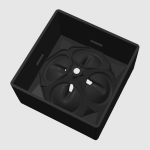
Interior, drivers mounted:
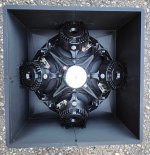
Before closing - damping wool applied to prevent enclosure resonances:
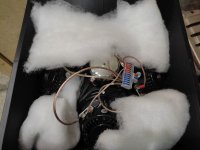
Closed. I chose a wooden rear wall. Enclosure was sealed with glue and body sealant:
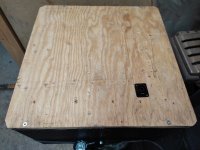
Acoustical measurements
References for my equipment, methodics, accuracies etc.:
ARTA Ring Trial #3
Performing large signal (maximum SPL) measurements like the pros - my case study
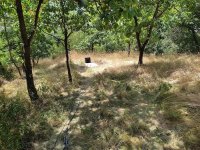
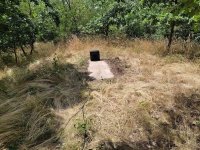
Raw (unfiltered) sensitivity, on axis, scaled to 1m 4pi; 2 Vrms for the 4x16 ohm parallel = 4 ohm mids, 2,83 Vrms for the 8 ohm tweeter:
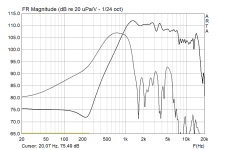
Frequency response & phase, complete speaker, with (active, FIR) filters / crossover:
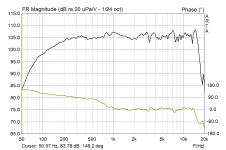
Burst decay:
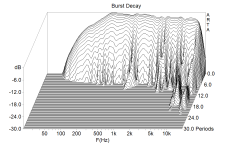
Directivity normalized, left chart horizontal, right chart vertical; 1m 4pi, gated, valid from ~500 Hz upwards; -90 - 90° in 5° steps, then an additional 180° step; 1/3 oct smoothed:
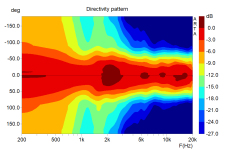
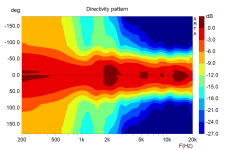
Harmonic distortion at from left to right 90, 100, 110, 120 dB. Higher harmonics might (partially) lie in the noisefloor of the signal chain. HP 2nd order @ 200 Hz used for the 120 dB measurement for speaker protection:
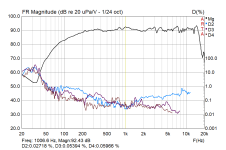
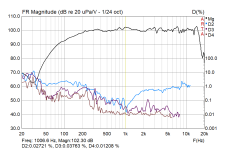
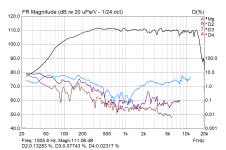
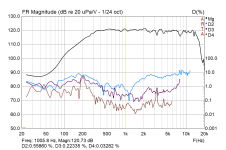
Multitone distortion (6 tones / oct, EIA-426B output filter) at from left to right top row 90 & 100, bottom row left to right 110 & 120 dB RMS. Again, HP 12dB/oct @ 200 Hz used for the 120 dB measurement for speaker protection:
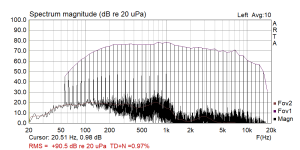
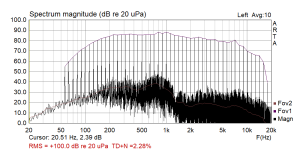
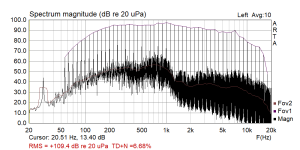
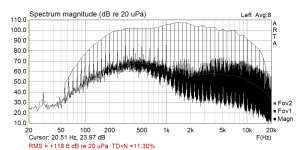
Max. SPL @ 3% THD; short video snippet (warning - loud):
Result; black curve is the Solana, and I threw in a line array of four 6ND430 in closed box in green, and a TW Audio M12 high performance 12/1,4" commercial PA top in blue as comparison objects:
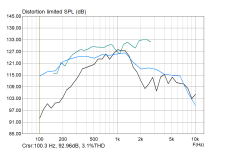
Listening impression, opinion & conclusion: I was quite looking forward to measuring & listening to this speaker. Over the past few deacdes, I've listened to pretty much everything that audio has to offer - but so far, never a MEH. I didn't really know what to expect either.
As for the measurements, the ports do seem to increase distortion, but in return you're getting really nice constant directivity in both axis. So it's a tradeoff, and it's up to you to decide what's more important to you.
As for listening impressions, the Solana turned out to sound just like a normal PA top. My ears can't make out anything extraordinary. Sorry for the boring description, but it's probably more of a compliment to the speaker than anything else. I listened to up to around 110 dB or so, and at that point, as usual with pretty much all PA tops, the compression driver gets somewhat harsh - but until then, the modded Solana was playing really decent.
That's it. I hope you vicariously enjoyed this little endeavour.
- Stoneeh
First, thank you @galucha for creating and publishing the Solana.
Since I had one DH450 8 ohm in stock, and also had two 18Sound 6ND430 16 ohm lying around and could source two others from a DIY speaker of mine, and also have a printer and could spare a couple of kgs of filament, I decided to create a mod of the Solana with 6ND430 as low-mids, as a closed pure Top (speaker that lacks bass capability and needs subwoofer support).
3D Model (w/o rear wall):

Interior, drivers mounted:

Before closing - damping wool applied to prevent enclosure resonances:

Closed. I chose a wooden rear wall. Enclosure was sealed with glue and body sealant:

Acoustical measurements
References for my equipment, methodics, accuracies etc.:
ARTA Ring Trial #3
Performing large signal (maximum SPL) measurements like the pros - my case study


Raw (unfiltered) sensitivity, on axis, scaled to 1m 4pi; 2 Vrms for the 4x16 ohm parallel = 4 ohm mids, 2,83 Vrms for the 8 ohm tweeter:

Frequency response & phase, complete speaker, with (active, FIR) filters / crossover:

Burst decay:

Directivity normalized, left chart horizontal, right chart vertical; 1m 4pi, gated, valid from ~500 Hz upwards; -90 - 90° in 5° steps, then an additional 180° step; 1/3 oct smoothed:


Harmonic distortion at from left to right 90, 100, 110, 120 dB. Higher harmonics might (partially) lie in the noisefloor of the signal chain. HP 2nd order @ 200 Hz used for the 120 dB measurement for speaker protection:




Multitone distortion (6 tones / oct, EIA-426B output filter) at from left to right top row 90 & 100, bottom row left to right 110 & 120 dB RMS. Again, HP 12dB/oct @ 200 Hz used for the 120 dB measurement for speaker protection:




Max. SPL @ 3% THD; short video snippet (warning - loud):
Result; black curve is the Solana, and I threw in a line array of four 6ND430 in closed box in green, and a TW Audio M12 high performance 12/1,4" commercial PA top in blue as comparison objects:

Listening impression, opinion & conclusion: I was quite looking forward to measuring & listening to this speaker. Over the past few deacdes, I've listened to pretty much everything that audio has to offer - but so far, never a MEH. I didn't really know what to expect either.
As for the measurements, the ports do seem to increase distortion, but in return you're getting really nice constant directivity in both axis. So it's a tradeoff, and it's up to you to decide what's more important to you.
As for listening impressions, the Solana turned out to sound just like a normal PA top. My ears can't make out anything extraordinary. Sorry for the boring description, but it's probably more of a compliment to the speaker than anything else. I listened to up to around 110 dB or so, and at that point, as usual with pretty much all PA tops, the compression driver gets somewhat harsh - but until then, the modded Solana was playing really decent.
That's it. I hope you vicariously enjoyed this little endeavour.
- Stoneeh
Stoneeh,
Interesting comparison, only 103dB at 200 Hz at 3% distortion for 4x6.5" seems very poor, excursion should be only ~025 millimeter at that level.
The line array of four 6ND430 appear to have about +12dB more 3% distortion limited output below ~300 Hz, what was their enclosed volume and the Solana's enclosed volume?
What is the print thickness of the Solana horn?
What excursion can the 6.5" do before the surround or cone contacts the cone filler?
Art
- Home
- Loudspeakers
- Multi-Way
- Portable Battery Powered MEH Build